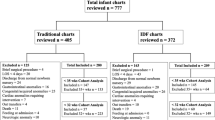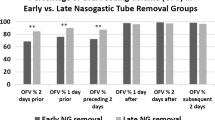Abstract
Objective
Our neonatal intensive care unit utilizes remote patient monitoring to facilitate hospital discharge with nasogastric tube (NGT) feeds. Program implementation, patient characteristics, and initial outcomes are described.
Study design
Data was collected prospectively in this implementation study. Descriptive statistics define weight gain, number of NGT feed days, number of days on monitoring, and physician time spent. Patient characteristics, readmissions, and implementation details are described.
Results
One-hundred and four babies consented to and completed data collection. Average weight gain on monitoring was 31.4 g/day (SD 10.2). Eighty-nine babies (85.6%) achieved full oral feeds while on the program, requiring a median 5 NGT feed days (IQR 2–13) and a median 15 days on monitoring (IQR 11–27). Average physician time spent was 9.1 min per day (SD 3.7). Six babies (5.8%) had unscheduled readmissions while on the program.
Conclusion
Remote monitoring programs can facilitate discharge for babies with continued NGT needs.
This is a preview of subscription content, access via your institution
Access options
Subscribe to this journal
Receive 12 print issues and online access
$259.00 per year
only $21.58 per issue
Buy this article
- Purchase on Springer Link
- Instant access to full article PDF
Prices may be subject to local taxes which are calculated during checkout
Similar content being viewed by others
References
American Academy of Pediatrics Committee on F, Newborn. Hospital discharge of the high-risk neonate. Pediatrics. 2008;122:1119–26.
Edwards L, Cotten CM, Smith PB, Goldberg R, Saha S, Das A, et al. Inadequate oral feeding as a barrier to discharge in moderately preterm infants. J Perinatol. 2019;39:1219–28.
Ortenstrand A, Waldenstrom U, Winbladh B. Early discharge of preterm infants needing limited special care, followed by domiciliary nursing care. Acta Paediatr. 1999;88:1024–30.
Meerlo-Habing ZE, Kosters-Boes EA, Klip H, Brand PL. Early discharge with tube feeding at home for preterm infants is associated with longer duration of breast feeding. Arch Dis Child Fetal Neonatal Ed. 2009;94:F294–7.
Lundberg B, Lindgren C, Palme-Kilander C, Ortenstrand A, Bonamy AK, Sarman I. Hospital-assisted home care after early discharge from a Swedish neonatal intensive care unit was safe and readmissions were rare. Acta Paediatr. 2016;105:895–901.
van Kampen F, de Mol A, Korstanje J, Groof FM, van Meurs-Asseler L, Stas H, et al. Early discharge of premature infants <37 weeks gestational age with nasogastric tube feeding: the new standard of care? Eur J Pediatr. 2019;178:497–503.
Sturm LD. Implementation and evaluation of a home gavage program for preterm infants. Neonatal Netw. 2005;24:21–5.
Evanochko C, Jancs-Kelley S, Boyle R, Fox M, Molesky M, Byrne P. Facilitating early discharge from the NICU: the development of a home gavage program and neonatal outpatient clinic. Neonatal Netw. 1996;15:44.
Ahnfeldt AM, Stanchev H, Jorgensen HL, Greisen G. Age and weight at final discharge from an early discharge programme for stable but tube-fed preterm infants. Acta Paediatr. 2015;104:377–83.
Lagatta JM, Uhing M, Acharya K, Lavoie J, Rholl E, Malin K, et al. Actual and potential impact of a home nasogastric tube feeding program for infants whose neonatal intensive care unit discharge is affected by delayed oral feedings. J Pediatr. 2021;234:38–45.e2.
Khalil ST, Uhing MR, Duesing L, Visotcky A, Tarima S, Nghiem-Rao TH. Outcomes of infants with home tube feeding: comparing nasogastric vs gastrostomy tubes. JPEN J Parenter Enter Nutr. 2017;41:1380–5.
Mago-Shah DD, Malcolm WF, Greenberg RG, Goldstein RF. Discharging medically complex infants with supplemental nasogastric tube feeds: impact on neonatal intensive care unit length of stay and prevention of gastrostomy tubes. Am J Perinatol. 2021;38:e207–14.
Williams SL, Popowics NM, Tadesse DG, Poindexter BB, Merhar SL. Tube feeding outcomes of infants in a Level IV NICU. J Perinatol. 2019;39:1406–10.
White BR, Ermarth A, Thomas D, Arguinchona O, Presson AP, Ling CY. Creation of a standard model for tube feeding at neonatal intensive care unit discharge. JPEN J Parenter Enter Nutr. 2020;44:491–9.
Ermarth A, Thomas D, Ling CY, Cardullo A, White BR. Effective tube weaning and predictive clinical characteristics of NICU patients with feeding dysfunction. JPEN J Parenter Enter Nutr. 2020;44:920–7.
Foster C, Schinasi D, Kan K, Macy M, Wheeler D, Curfman A. Remote monitoring of patient- and family-generated health data in pediatrics. Pediatrics. 2022;149:e2021054137.
Garne Holm K, Brodsgaard A, Zachariassen G, Smith AC, Clemensen J. Participatory design methods for the development of a clinical telehealth service for neonatal homecare. SAGE Open Med. 2017;5:2050312117731252.
Holm KG, Clemensen J, Brodsgaard A, Smith AC, Maastrup R, Zachariassen G. Growth and breastfeeding of preterm infants receiving neonatal tele-homecare compared to hospital-based care. J Neonatal Perinat Med. 2019;12:277–84.
Hagi-Pedersen MB, Dessau RB, Norlyk A, Stanchev H, Kronborg H. Comparison of video and in-hospital consultations during early in-home care for premature infants and their families: a randomised trial. J Telemed Telecare. 2022;28:24–36.
Gund A, Sjoqvist BA, Wigert H, Hentz E, Lindecrantz K, Bry K. A randomized controlled study about the use of eHealth in the home health care of premature infants. BMC Med Inf Decis Mak. 2013;13:22.
Robinson C, Gund A, Sjoqvist BA, Bry K. Using telemedicine in the care of newborn infants after discharge from a neonatal intensive care unit reduced the need of hospital visits. Acta Paediatr. 2016;105:902–9.
Vergales BD, Murray PD, Miller SE, Vergales JE. Safety and efficacy of a home nasogastric monitoring program for premature infants. J Neonatal Perinat Med. 2022;15:165–70.
Bardach SH, Perry AN, Kapadia NS, Richards KE, Cogswell LK, Hartman TK. Redesigning care to support earlier discharge from a neonatal intensive care unit: a design thinking informed pilot. BMJ Open Qual. 2022;11:e001736.
Hannan KE, Hwang SS, Bourque SL. Readmissions among NICU graduates: who, when and why? Semin Perinatol. 2020;44:151245.
Acknowledgements
Thank you to the OHSU Foundation, Doernbecher Philanthropy Board, and the donors who made the creation of Growing @ Home a possibility. Thank you to Brooke Vergales, MD, University of Virginia, for her guidance in creating our remote patient monitoring program, and to Dmitry Dukhovny MD, MPH and Robert Schelonka, MD, Oregon Health & Science University, for their review of the manuscript.
Author information
Authors and Affiliations
Contributions
CF carried out the initial analysis and interpretation of the data, drafted the initial manuscript, and reviewed and revised the manuscript. MH carried out final analysis of the data, reviewed and revised the manuscript. AD and AK conceptualized and designed the study, participated in acquisition of data, and reviewed and revised the manuscript. JBW conceptualized and designed the study, participated in and supervised data collection, participated in data analysis and interpretation, and critically reviewed the manuscript for important intellectual content. All authors approved the final manuscript as submitted and agree to be accountable for all aspects of the work.
Corresponding author
Ethics declarations
Competing interests
The authors declare no competing interests.
Ethics approval
The study was approved by the Institutional Review Board at Oregon Health & Science University (#19657). The study was performed in accordance with the Declaration of Helsinki.
Additional information
Publisher’s note Springer Nature remains neutral with regard to jurisdictional claims in published maps and institutional affiliations.
Rights and permissions
Springer Nature or its licensor (e.g. a society or other partner) holds exclusive rights to this article under a publishing agreement with the author(s) or other rightsholder(s); author self-archiving of the accepted manuscript version of this article is solely governed by the terms of such publishing agreement and applicable law.
About this article
Cite this article
Fisher, C., Haag, M., Douglas, A. et al. Remote monitoring for neonates requiring continued nasogastric tube feeding: implementation, patient characteristics, and early outcomes. J Perinatol 43, 1125–1130 (2023). https://doi.org/10.1038/s41372-023-01732-2
Received:
Revised:
Accepted:
Published:
Issue Date:
DOI: https://doi.org/10.1038/s41372-023-01732-2



